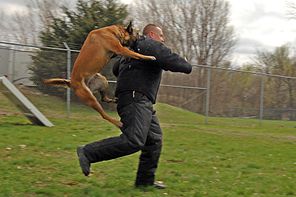Police dog


A police dog (also called a K-9) is a dog trained to help police and other law enforcement people. German Shepherds are the most common breed, but other breeds are also used. If a police dog is killed in duty, it is usually given a full police funeral.[1] K-9s are often given their own ballistic vests, and some are given their own police IDs and badges.[2]
What can police dogs do?[change | change source]
A police dog may be trained to do one special thing, or a few different things. Common K-9 jobs include:[3]
- Searching for drugs (for example, in prisons or during arrests)
- Searching for explosives
- Searching for crime scene evidence
- Chasing and holding suspects
- Making suspects less likely to fight police because of fear that the dog will be released (this is called "bark and hold" - the dog barks aggressively to scare the suspect while its handler holds its leash)
- Protecting police officers
Specialized police dogs[change | change source]
There are also specialized police dogs, who are used only for a specific job because they have special skills or training for that job. For example:
- Sentry and attack dogs find and catch suspects or enemies. They also provide security for important areas.
- Search and rescue dogs (SAR) find missing people, people who are running from the police, or missing objects. Bloodhounds are often used for this task because they are very good at sniffing out and following scents from people or objects.
- Detection or explosive-sniffing dogs scent (smell) illegal drugs and explosives. In many countries, beagles are used in airports to sniff people's baggage for items that are not permitted. Because beagles act and look very friendly, they do not worry most passengers.[4]
- Arson dogs are trained to detect traces of accelerants (things that would start or worsen a fire) at sites of suspected arson.
- Cadaver dogs are trained to sniff out decomposing bodies. Dogs' noses are so sensitive that they are even able to smell bodies that are under running water[5] Important work was done by Dr. Debra Komar at the University of Alberta, along with the RCMP Civilian Search Dog Association[6] in this area. As a result, training techniques were developed, and cadaver-sniffing dogs now have near 100% accuracy rates.[7] Her research has been published in the Journal of Forensic Anthropology.
Popular breeds[change | change source]

Different breeds of police dogs tend to be good at different things. However, any good police dog should be intelligent, aggressive, strong, and have a good sense of smell. Many police dogs are male and not neutered (because neutering can make a dog less aggressive). However, there are female police dogs, which are used for rescue, tracking, and locating bombs and drugs.[8] German Shepherd Dogs and Belgian Malinois are the most commonly used; however, other dog breeds (and their specialties) include:[8]
- American Pitbull Terrier (skilled at search and rescue/tracking, attack dogs, and finding bombs and drugs)
- Beagle (good at locating bombs and drugs. Used worldwide.)
- Belgian Malinois (often used for protection, attack dogs, finding IEDs, finding evidence and drugs, prisoner transport, and human tracking.)
- Bloodhound (very good at tracking and identifying things by their smell; used for tracking and locating bombs, drugs, and evidence.)
- Doberman Pinscher (used as a protection and attack dog)
- Dutch Shepherd (also used as a protection and attack dog)
- Springer Spaniel (good at locating bombs and drugs)
- German Shepherd Dog (often used for protection, attack dogs, ground-based tracking, air-based tracking, and finding dead bodies, drugs, evidence, and IEDs)
- German Shorthaired Pointer (good at ground-based tracking and air-based tracking, as well as finding drugs and evidence)
- Labrador Retriever (skilled at locating bombs and drugs)
References[change | change source]
- ↑ "K-9's memorial: 'It was a tough day'". Pittsburgh Post-Gazette. Retrieved February 17, 2014.
- ↑ "So Help You, Dog". Slate. July 18, 2008. Retrieved February 17, 2014.
- ↑ "K9 Unit: Duties and Responsibilities". New York State Department of Environmental Conservation. Archived from the original on August 3, 2017. Retrieved April 14, 2014.
- ↑ "BBC NEWS - UK - Magazine - The unlikely enemy of the terrorist". bbc.co.uk. July 13, 2005.
- ↑ "Search and Resue Dogs". K9 Centre. Australia. Archived from the original on November 21, 2008.
- ↑ "canadiansearchdogs.com". Canadiansearchdogs.com. Archived from the original on April 12, 2006.
- ↑ Oesterhelweg, L.; Kröber, S.; Rottmann, K.; Willhöft, J.; Braun, C.; Thies, N.; Püschel, K.; Silkenath, J.; Gehl, A. (2008). "Cadaver dogs—A study on detection of contaminated carpet squares". Forensic Science International. 174 (1): 35–9. doi:10.1016/j.forsciint.2007.02.031. PMID 17403590. Archived from the original on September 26, 2010. Retrieved November 27, 2015.
- ↑ 8.0 8.1 Grabianowski, Ed (May 3, 2004). "How Dogs Work". HowStuffWorks, Inc. Retrieved March 27, 2014.
Other websites[change | change source]
- National Police Canine Association (United States)
